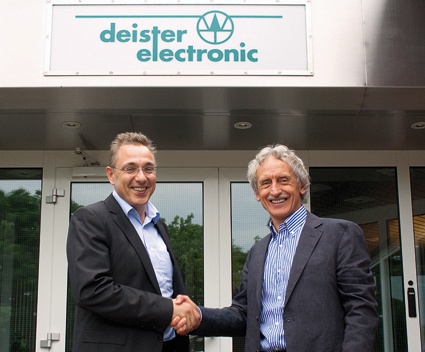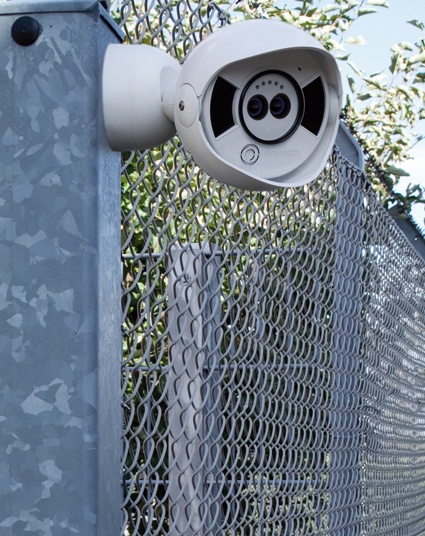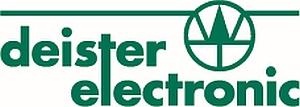Deister electronic: Two Heads Are Better than One
It‘s the first time in the 35-year history of deister electronic: founder and owner Anatoli Stobbe appointed his Commercial Director Marco Abrahms to the Executive Board on the 1st...



It‘s the first time in the 35-year history of deister electronic: founder and owner Anatoli Stobbe appointed his Commercial Director Marco Abrahms to the Executive Board on the 1st July 2012 and effectively formed a diarchy. "A man of my hearts desire", said Anatoli Stobbe. GIT-SECURITY.com spoke with Marco Abrahms about the new constellation and about current technical developments in the company.
GIT-SECURITY.com: Mr Abrahms, you have been a member of Senior Management at deister electronic since 1st July 2012. It is the first time, there has been a second man at the helm beside the founder and owner, Anatoli Stobbe. What is the reason for this new structure?
Marco Abrahms: I wouldn‘t talk of a new structure but rather of an addition to the competencies within the Management. It is the first step in making deister electronic organizationally fit for the future. We will be celebrating our 35 year company anniversary next year. Anatoli Stobbe himself has significantly driven the company forward using his innovative ambition and ideas and built it up to a competent and leading RFID solutions provider worldwide.
Could you give us a brief summary of your security portfolio?
Marco Abrahms: The Security & Safety division at deister encompasses modern solutions for people and vehicle access control, guard tour services and electronic Management for keys and valuables. Some typical customers amongst others are, security companies, the police, border protection agencies, prisons, the postal and parcel services, state organizations, industrial and trading companies, airports and airlines, financial institutes as well as hospitals and surgeries. In its Ident & Automation division deister offers electronic read and write units that are especially suitable for data collection in an industrial environment and for optimizing the flow of goods.
So who are your most important customers in this respect?
Marco Abrahms: Typical areas of application for these products are production automation, transport and logistics, goods flow control, securing vehicles as well as new markets that can benefit from the special advantages of UHF technology. Typical customer groups are logistic companies, industries, parcel services, retail companies, waste management service providers and the textile and laundry industries.
Let‘s come back to the new management - how are the responsibilities divided in this new topography?
Marco Abrahms: In general, the two CEOs reciprocally support each other. The responsibilities in the Management Board are restructured. Mr Stobbe will continue in his function as Senior Product Manager, looking after R&D as well as the Sales Departments. All other responsibilities of the company are assigned to myself. These include Accounting, IT, Purchasing, Order Processing as well as Sales Support. The latter plays an important coordinating role between our in- house and field sales staff. In addition, I am also responsible for Marketing, which is currently being expanded.
Could you give us an insight into your strategic aims to develop the company in
the coming years?
Marco Abrahms: First of all I would like to establish a solid foundation for further company growth. As a first step I want to optimize the procedural structures. Regardless of the different industry, the processes in all companies are very much the same. At the moment, all our processes are being looked at and redesigned. If necessary they mesh together without any gaps. Mistakes that can be avoided should be eliminated by defined processes. It is very important to me that every employee feels responsible for his particular job and reacts accordingly. We will happily give them the space so that they can act on their own authority. This is a most important task for me if we want to improve our goal oriented teamwork. I expect that we will have completed optimizing the operational processes by the beginning of next year. In parallel we are working towards matching our versatile product solutions even more consistently to the needs of our customers. We appointed a Head of Marketing in August who will bundle existing activities and develop them further.
Mr Abrahms, you have recently taken over the Syntron company, a specialist for IT-based security systems. What made you take this step and does this decision fall into the corresponding growth strategy of deister?
Marco Abrahms: We have had the amanTag product range in our portfolio for over 15 years, which primarily concentrates on Asset Protection applications. We have, for example, installations in the Louvre in Paris, in English prisons, in casinos, to give just a few applications. The Syntron company has mainly been active in healthcare and has an excellent reputation, particularly in the areas of baby protection, roaming patient protection and employee emergency call and location. For this reason the takeover of the capital and current assets from the insolvency have made a very interesting addition to our existing portfolio.
How is this company being integrated and what is the progress so far?
Marco Abrahms: We took over Syntron mainly to carry on the RFAPP division. RFAPP stands for Radio Frequency Asset & People Protection and was introduced to the market by Syntron with growing success. We were able to secure the services of the former Head of Sales, Uwe Bartels, and two Service Engineers from Syntron to continue this division for us. With them we already have good access to the market and we are currently cementing the existing customer relationships. The current RFAPP products are being technically revamped. It is to be expected that a new product generation will be brought to market in the new year.
If you look at the Security & Safety and Ident & Automation segments, where do you see the most important areas of development in these two markets for deister electronic?
Marco Abrahms: A paradigm change is currently in progress in the automotive industry. LF and HF to UHF technologies will be replaced by UHF technology. This is a very interesting direction as one of deister's main expertise is based on UHF technology. Just as interesting are the textile industry and leasing markets in that matter. By implementing our UHF technology to textiles such as clothing or rental laundry items we are going down a trend-setting path. We are now creating cross-system solutions in the security and safety divisions. The management of keys and/or valuables also complete some of the tasks usually performed by security services. A key, for example, that you have just issued with the key management system is not allowed to leave the prison either during or after its use. This is where the RFAPP or amanTag system comes into play. Or a security vehicle is captured by a tranSpeed long range reader as it approaches. It is very beneficial for the users of all these combined systems as only one database must be maintained with just one GUI. There are also no compatibility discussions if existing systems are extended because all interfaces and data protocols are perfectly in tune with one another.
With proxEntry, proxSafe, dataLog and tranSpeed, you have a comprehensive portfolio of security products on the market. What are the newest additions here or the announcements coming soon?
Marco Abrahms: proxEntry, our access control components such as contactless readers and the corresponding transponders that we have very successfully brought into the OEM market over many years, are currently getting a security boost. After Mifare Classic and Legic Prime were hacked, almost all operators of access control systems rely on AES-encoded readers and card technologies such as Mifare Desfire EV1 or Legic Advant. deister has developed the new ‚Secureprox‘ highly-secure readers and card family. Nowadays almost all smartphones incorporate an NFC module that allows a payment function, with which access rights can also be downloaded. Newer models of the proxEntry reader family on the PRM and CRM platforms support the NFC functions. To date however, it has not been definitively defined exactly where the ‚secure element‘ in smartphones actually sits or in which part the security key is stored. Just recently the ‚Google Wallet‘ application was hacked, as the security key was simply deposited in the memory.
A trend are definitely UHF long-range readers?
Marco Abrahms: UHF long-range readers are not only used for ‚hands-free‘ access control but also to track employees or visitors in a building. In addition to the TSU 100 and TSU 25 readers, deister electronic has also developed a very special dual-technology transponder in the size of a conventional credit card that contains not only a highly secure HF component with Mifare Desfire EV1 or Legic advant but is also paired with a UHF transponder that permits a read range of many meters. The highlight of the card is the specially developed combi-antenna. It has been laid out so when it is being carried on the body, for example as a visible visitor ID, the signal is hardly suppressed by the body at all and the visitor can therefore be discreetly identified during his movement through the building by each reader installed in the roof space.
Has something been happening with proxSafe?
Marco Abrahms: The proxSafe division is offering a completely revised proxSafe flexx family. The customer can choose between five different housings of the flexx products and fit further key panels themselves at any time. This means that an economic starter system can grow over time with demand. The already very comprehensive product portfolio has been extended with a new C6 terminal that is operated via a graphic screen and a touch panel. Target markets that use Cyrillic, Japanese, Arabic or even Chinese characters can thereby be perfectly addressed.
... and with guard tour control?
Marco Abrahms: The oldest division of our company is receiving a brand new-developed data collector. The guardiX that has been used to great success to date has been upgraded with two new features. The housing is now water protected to IP67. In addition, there are models that correspond to the ATEX regulations and can be used in petrochemical installations. Devices that fall under the ATEX regulations must be conceived and constructed from the beginning so that the ignition of an explosive atmosphere is prevented or the effects of this are suppressed to a satisfactory degree. As both the guardiX and the guardiX II can optionally be fitted with a Bluetooth module, online communication via a mobile phone or a smartphone. To support online applications where guard tour must be supervised in real time to optimally protect people and valuables, deister has set up its own Cloud Service that can be used free of charge to transport data-telegrams from each mobile device to the control center.
Let‘s move to the tranSpeed division ...
Marco Abrahms: The tranSpeed division that forms the basis of all long range readers, presents a new midrange reader, the TSU 200, that permits reading ranges - in parking lots - of up to seven meters. To identify vehicles it is important not just to get the maximum read range, as many players in the market seem to have as their priority. It is rather important to be able to identify standard vehicles as well as high-end vehicles with heat and UV-suppressing windshields at the same reliable read range. Therefore two UHF transponders are specially developed as windshield transponders for standard and high end vehicles with a maximum read range of ten meters. They can be adapted according to the necessary distance of up to five or six meters. So every division has a number of very exciting technical highlights and innovations to offer. We are continuing to ensure that all these divisions can be perfectly combined through interfaces and data protocols.
What other products and developments are currently in the foreground for you?
Marco Abrahms: Firstly, the eyewatch camera project that is now coming to market after its first presentation at Security 2010. The eyeTWO all-in-one IP camera has been conceived for external use. It is an intelligent‘ camera; that means that it can be used as an autonomous video sensor. Software that runs in the camera itself - e.g. movement analysis software - can then activate an alarm, sends an SMS or load the images onto the internet. The numerous other features would take up too much space here. We presented the eyewatch camera at the Security show in Essen on a separate booth in the Video Hall. A further focus is the doorLoxx brand. This system provides mechatronic products such as electronic lock cylinders, strikers or modular locks. It was also shown for the first time at Security 2010. We had already received a large order even before the show was over. This kept us busy with doorLoxx for almost a whole year. After successfully completing the project, we converted the already implemented items into series products. Naturally there was plenty of new equipment for the mechatronic expert to look at, at this year's Security event.
What were the main intentions of your presentation at Security in Essen this year?
Marco Abrahms: We concentrated this year on the presentation of the new products and solutions that I mentioned before and on the further development of our valued quality. Especially the eyeTWO camera or the doorLoxx mechatronic division lie close to our heart. We believe that both, video technology and also mechatronics have a future in the security market. As with any new product, a lot has been invested, a number of patents have been applied for and thereby good ideas incorporated into innovative products.
Thank you for the interview Mr Abrahms.
most read


Video security & video management: the winners of category C at the GIT SECURITY AWARD 2026
GIT SECURITY AWARD 2026: Video Security & Video Management - an overview of the most innovative solutions

The Benefits of AI-based Video Surveillance Solutions for Sports Venues
Dallmeier Interview: Artificial intelligence Makes Stadiums Smarter

GIT SECURITY AWARD 2026 - The winners have been announced!
GIT SECURITY AWARD 2026: The best safety and security solutions of the year - now an overview of all winners

Is Your Venue Ready for Martyn’s Law?
Martyn’s Law demands stronger security by 2027. Is your venue prepared to protect and respond?









